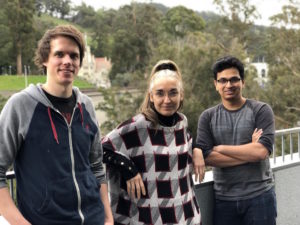In two new studies, a team of researchers led by Eva Nogales, senior faculty scientist in the Molecular Biophysics and Integrated Bioimaging (MBIB) Division, has gained insight into the structure and function of molecules that act at the genetic level to give rise to different types of cells. Some of these molecules are a complex of proteins called the Polycomb Repressive Complex 2 (PRC2) that is involved in “silencing” genes so that they are not “read” by the cellular machinery that decodes genetic information, effectively keeping the genetic information in the “off” state.

From left: Simon Poepsel, Eva Nogales and Vignesh Kasinath (Credit: Basil Greber)
These two studies rely on cryo-electron microscopy (cryo-EM) for imaging PRC2, a technique that can be used to image large biomolecules on a very small scale and in multiple conformations. The cryo-EM structure of PRC2 and the ways in which it is regulated to affect gene silencing was reported on January 18 in the journal Science and on January 29 in Nature Structural and Molecular Biology by Eva Nogales and postdoctoral researchers Vignesh Kasinath and Simon Poepsel. For more information, read the Cancer Discovery Research Watch synopsis or the Berkeley Lab News Center press release.




